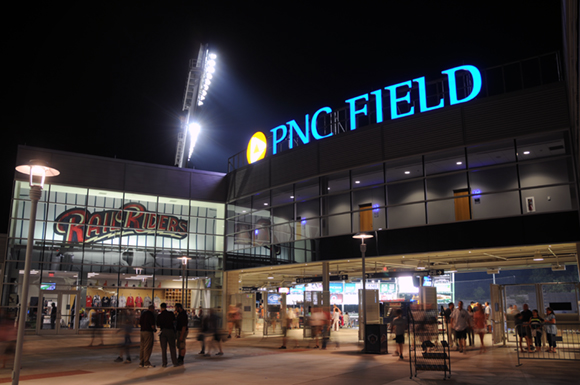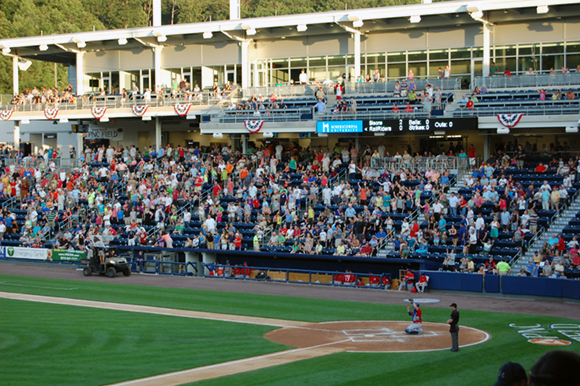
Another 2013 Ballpark Digest Award to announce: We’ve named PNC Field, home of the Scranton/Wilkes-Barre RailRiders (Class AAA; International League), as our Best New Ballpark of the Year.
Building a new ballpark on the base of an old one is an enormous challenge: what made sense in the 1980s may not make sense for a modern ballpark. And doing it all during a single season – demolition, reconstruction while building around retained features – is even more of a challenge. For these reasons, PNC Field is the choice as Best New Ballpark of 2013 by Ballpark Digest, the leading guide to baseball and ballparks on the Internet.
“Going down to the concrete and building anew is quite the architectural and engineering challenge,” said Kevin Reichard, publisher of Ballpark Digest. “We’re not talking mere renovation here: we’re talking dramatic makeover – basically, a new ballpark. That’s why we’re honoring PNC Field as our best new ballpark of the year.”

Home of the International League’s Scranton/Wilkes-Barre RailRiders, Triple-A affiliate of the New York Yankees, PNC Field reopened this season after the SWB franchise spent the 2012 season on the road. Opening in 1989, the original Lackawanna County Stadium was a two-deck monstrosity seating nearly 11,000, built at a time when the goal was to fill as many seats as possible and not worry about the amenities fans expect today.
“What a tremendous honor,” said RailRiders president/GM Rob Crain. “So many people made this dream a reality and on behalf of everyone that was involved and our fans here in Northeast Pennsylvania, sincere thanks to Kevin Reichard and Ballpark Digest. We believed the reconstructed PNC Field ranked among the best in baseball. This award cements that status.”
“We are delighted for PNC Field to have received this recognition,” said Mandalay Baseball CEO Art Martin. “We are extremely excited about what the new ballpark and the team mean to the community of Northeast Pennsylvania and appreciate the collaborative efforts of everyone who helped turn this dream into a reality for the great baseball fans across this region.

The challenge, as undertaken by Philadelphia firm EwingCole, was to take a hulking pile of concrete and turn it into a fan-friendly venue. The plan was dramatic: take down the second deck, put in a 360-degree concourse, install new comfortable seating and second-level suites and club, add group spaces to outfield areas and spruce up virtually everything else, from concessions to restrooms. Again: it would have been easier to just bulldoze the old ballpark and put up a new one, but the decision was made to reuse where possible – so the end result was a new ballpark built on the base of the old one. The total cost of the renovations, as constructed by Alvin H. Butz, Inc., was $43.3 million. With new Triple-A ballparks now costing $60-million plus, there was a definite cost savings to the new ballpark/renovation plan.

In the end, the fans responded: the RailRiders drew 435,839 fans to PNC Field this season, the best year at the gate since 2008.
“The easy path would have been to bulldoze PNC Field and build somewhere else,” Reichard said. “The PNC Field site is one of the most scenic – and challenging – in all of baseball. Keeping the ballpark in its present spot and reusing what was appropriate is a welcome trend in architecture, and PNC Field is a prime example of building new on top of the old in a cost-effective manner.”
“We are delighted that the transformative renovation of PNC Field has been recognized as Ballpark of the Year,” said Craig Schmitt, RA, principal at EwingCole. “One of the main goals for both the county and the team was to design an intimate and fan-friendly ballpark. There is a legacy of baseball in this region and this ballpark will carry that forward for generations to come.”
This was perhaps the most competitive years for new ballparks since we saw Fort Wayne and Columbus facilities open in the same season. Our runner-up — and it was a very close one — was Regions Field, home of the Birmingham Barons (Class AA; Southern League). The ballpark was an instant hit in Birmingham: it generated economic activity in the area and brought in a whole new generation of baseball fans in the city. It also served as a blueprint for every other city debating bringing in baseball from the suburbs (yeah, we’re looking at you, Richmond). And, the design from HKS, Inc. and Hoskins Architecture was pretty spiffy: lots of discrete seating areas, group areas and signature elements like the center-field DRASH Scrapyard bar. Really, the big differences for us were the architectural, logistical and engineering challenges in building the new ballpark on the site of the old one.
Honorable mention goes to Fowler Park at the University of San Diego, where a 13.8 million ballpark renovation/creation basically created a new ballpark. For fans, the Populous design included a new entry plaza in the 16th Century Spanish Renaissance style connected the ballpark with the existing architecture on campus. There are five discrete levels at the ballpark: an entry level with plaza space, a suite and press level, the main concourse, the Torero Zone and the team clubhouse. The updated venue seats 1,700 and also includes a renovated playing field, new home and visitor dugouts and renovated batting and practice tunnels.
For the players, the new ballpark created comprehensive experience for the baseball student athlete. Fowler Park debuted a new 6,800-square-foot team clubhouse that includes reception, coaches offices, a player locker room, equipment room, lounge space and a training room, providing major league amenities to Torero players. The design focused on the student-athlete’s experience: studying, practicing, lounging and playing.
ABOUT THE BALLPARK DIGEST AWARDS
Each year Ballpark Digest honors noteworthy accomplishments in the baseball world, whether it be Major League Baseball, Minor League Baseball, independent baseball, summer-collegiate baseball or college baseball. Readers are asked to submit nominations for awards in specific categories; Ballpark Digest editors then go though the submissions (numbering some 300 pages of documentation last year). The awards cover both individual accomplishments as well as team accomplishments. This is the fifth season for the Ballpark Digest Awards. A complete listing of Ballpark Digest Awards can be found at ballparkdigest.com/awards.
